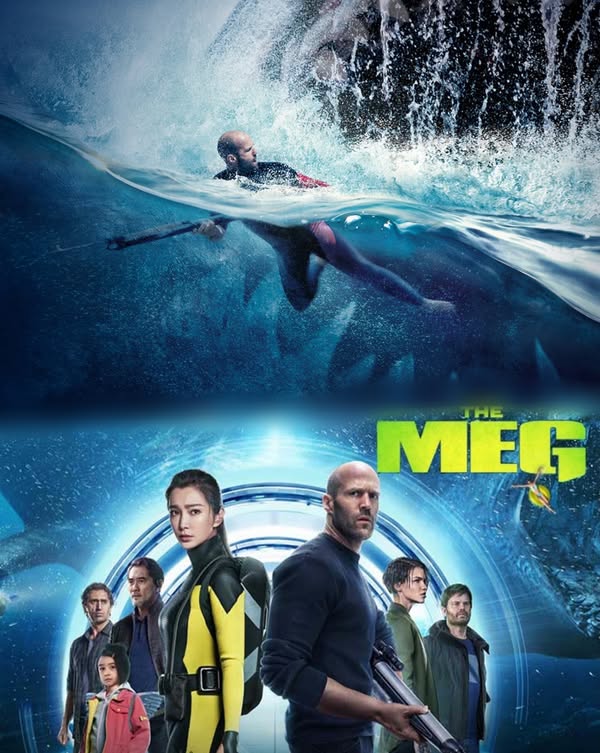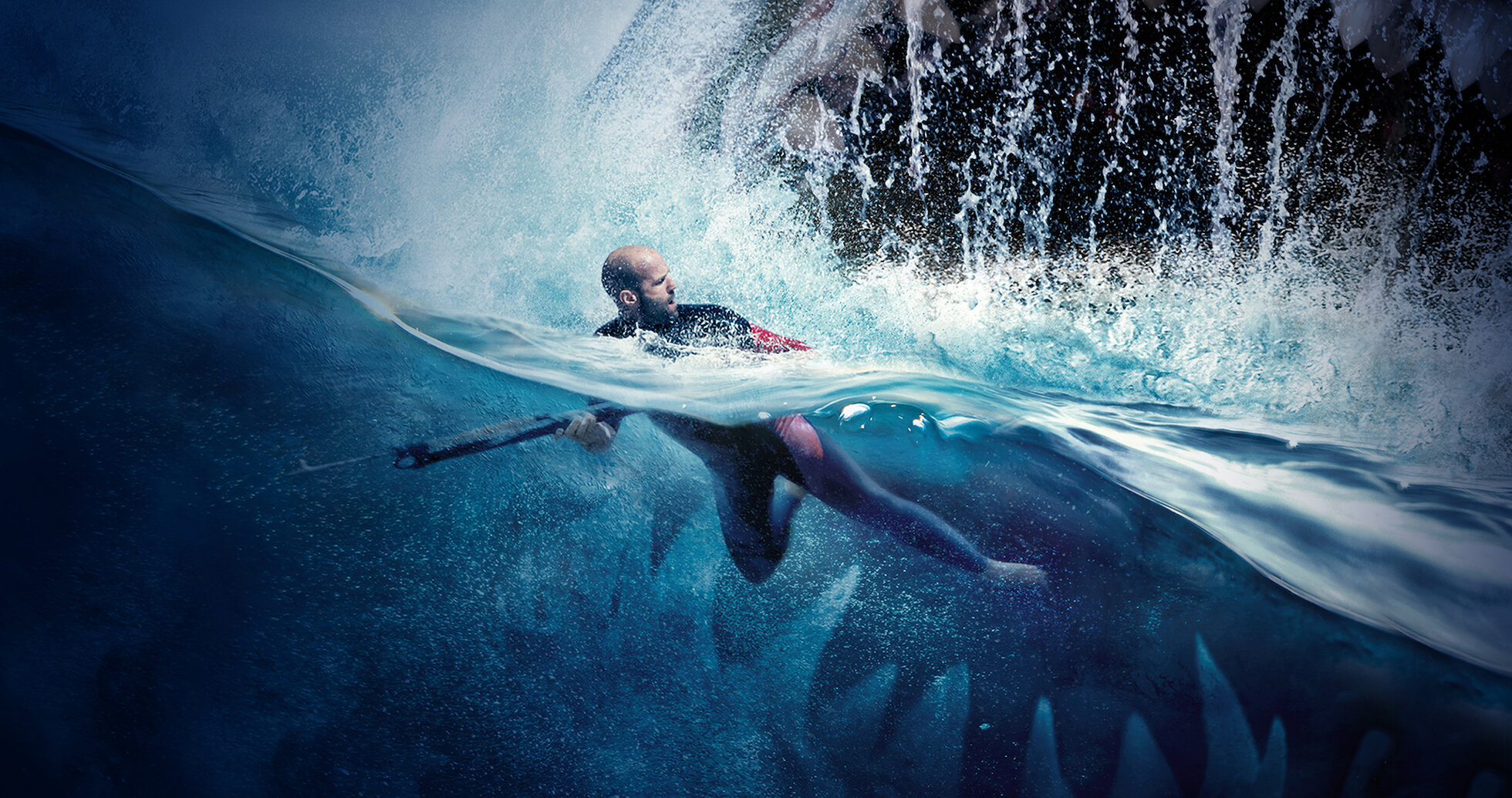🎬 The Meg (2018) – Survival in the Deep Blue! 🦈🌊

Related Movies:
I. Introduction: Between Science Fiction and Ancient Terror
When The Meg launched in 2018, it wasn’t just another shark movie — it was a cinematic resurrection of one of the most terrifying predators Earth has ever known: Carcharocles megalodon, the Megalodon. With a $130 million budget, Warner Bros. delivered a high-octane, sci-fi marine thriller directed by Jon Turteltaub (National Treasure), starring action icon Jason Statham.
Unlike more grounded marine thrillers (The Abyss, Deep Blue Sea), The Meg dares to blend scientific mystery with adrenaline-fueled action and a sprinkle of prehistoric horror. While it takes liberties with marine biology, its appeal lies in combining crowd-pleasing spectacle with a primal question: What if the oceans still hide monsters we thought long extinct?

II. The Plot: Terror From the Depths
The narrative begins in the Mariana Trench, the deepest natural point in Earth’s oceans. A team of scientists aboard the underwater station Mana One is conducting a risky dive beneath what they believe is the seabed — only to discover a thermocline hiding a deeper ecosystem. What they awaken from this abyss is not just biological wonder, but biological terror: the Megalodon — a 75-foot prehistoric shark.
The crew becomes stranded, and the one man with experience surviving such horrors is called in: Jonas Taylor (Jason Statham), a disgraced deep-sea rescue diver. Haunted by a past encounter with a mysterious underwater creature, Jonas must now confront his own trauma, rescue the team, and stop the newly resurfaced apex predator from wreaking havoc on the surface world.
As the plot unfolds, it becomes a race against time — and nature — to prevent a mass catastrophe, with Jonas leading a multi-national team against a living fossil whose hunger knows no limits.
Related Movies:
III. Themes Explored
1. Man vs. Nature
At its core, The Meg is a cinematic ode to the man vs. nature trope. Humanity’s ambition to explore and exploit the uncharted oceans comes with a price — the awakening of an ancient threat. The film echoes the cautionary message of Jurassic Park: “Just because we can, doesn’t mean we should.”
This theme is especially relevant today as real-world deep-sea mining and ocean drilling become more invasive. The Meg metaphorically reminds us that the ocean remains one of the least understood — and least controllable — frontiers.

2. Survival and Redemption
Jonas Taylor’s arc is that of redemption. Haunted by his decision to abandon crew members during a previous mission, Jonas sees this new threat as a chance to redeem himself — both in the eyes of others and within his own moral compass. His physical prowess is matched by a deeper emotional conflict, bringing a layer of human complexity to an otherwise high-octane narrative.
3. The Unknown
Beneath the surface lies more than just darkness; it lies the unknown. The Mariana Trench is not just a setting — it’s a symbol of humankind’s fear of what it cannot see or control. In this regard, the Megalodon represents the ultimate unknown: a primeval threat that modern technology cannot predict or contain.
IV. Cinematography and Visual Storytelling
Shot by cinematographer Tom Stern (known for his work with Clint Eastwood), The Meg balances grand scale with claustrophobic tension. The underwater scenes are immersive, crafted to mimic both the serene mystery and deadly danger of the deep.
Key Visual Highlights:
-
Thermocline Entry: The dive beneath the hidden layer of the trench uses a shifting color palette — from blue to murky green to pitch black — to indicate transition into the unknown. This is where The Meg transforms from a science expedition to a horror thriller.
-
The First Meg Reveal: The silhouette of the Megalodon against the bright lights of the submersible is not only terrifying but cinematic gold. It plays with the concept of scale — a tiny human machine versus a colossal predator.
-
Surface Chaos: When the Meg reaches tourist-laden beaches, the contrast between the bright, joyful environment and the looming underwater threat mirrors the horror of something ancient disrupting the illusion of modern safety.

V. Character Development and Cast Performances
While the plot centers around a monstrous shark, it’s the human drama that anchors the film emotionally.
1. Jonas Taylor (Jason Statham)
Statham brings both action-hero credibility and subtle pathos to Jonas. Though known for his physicality, his portrayal here adds a level of psychological depth — a diver fighting not just monsters but the guilt of past choices. His rapport with young Meiying (played by Shuya Sophia Cai) and his cautious romance with her mother, Suyin, humanizes the film.
2. Dr. Minway Zhang and Suyin (Winston Chao & Li Bingbing)
Representing scientific curiosity and moral responsibility, Dr. Zhang and his daughter Suyin bring emotional gravitas and cultural balance to the cast. Their dialogue often questions the ethics of exploration and the arrogance of believing humans have dominion over nature.
3. Jack Morris (Rainn Wilson)
As the eccentric billionaire financier of the expedition, Morris embodies corporate greed. He’s the classic trope of capitalist opportunism — eager to exploit discovery for profit, regardless of the consequences. His eventual downfall is not only poetic but also reinforces the narrative’s environmental critique.
Related Movies:
VI. Scientific Accuracy: What the Movie Got Right (and Wrong)
🧪 Fact vs. Fiction: The Megalodon
What’s Real:
-
The Megalodon was a real prehistoric shark species that lived roughly 23 to 3.6 million years ago during the early Miocene to Pliocene epochs.
-
Estimated lengths range from 50–70 feet based on fossilized teeth and vertebrae.
-
It was likely the top marine predator of its time, feeding on whales, dolphins, and other sharks.
What’s Fictional:
-
The idea that Megalodon could survive unnoticed in the Mariana Trench is biologically implausible. The extreme cold and lack of large prey at such depths would make long-term survival unsustainable.
-
The film portrays Megalodon as almost sentient, with behaviors bordering on revenge and strategy — more akin to Jaws than a real shark’s instincts.
However, these creative liberties are part of the appeal. The Meg isn’t a documentary — it’s a monster movie grounded in plausible science but driven by cinematic spectacle.

VII. Real-World Inspirations
The movie is based on Steve Alten’s 1997 novel Meg: A Novel of Deep Terror, part of a long-running book series. Alten’s writing combines paleontology, oceanography, and speculative fiction, which the film adapts into a tighter, more action-driven narrative.
Interestingly, some paleontologists have studied why Megalodons went extinct. Leading theories include:
-
Cooling oceans reducing habitable ranges.
-
Decline of prey populations, such as early whales.
-
Competition from modern Great White Sharks.
These extinction factors serve as background context to the film’s fictional resurrection of the species — a cinematic “what if.”
VIII. Critical Reception and Legacy
Upon release, The Meg garnered mixed reviews from critics but was widely embraced by global audiences. It earned over $530 million worldwide, making it one of the highest-grossing shark films after Jaws.
Critics praised:
-
Its commitment to fun, over-the-top action.
-
Statham’s charismatic performance.
-
The scale of underwater sequences.
Criticisms included:
-
A generic plotline.
-
Some pacing issues.
-
Predictable character arcs.
Yet for fans of the creature-feature genre, The Meg stands tall — or rather, swims deep — as a throwback to monster movies with modern CGI polish.
IX. The Sequel and the Future: The Meg 2 – The Trench
Due to its commercial success, The Meg spawned a 2023 sequel titled The Meg 2: The Trench, directed by Ben Wheatley. This installment dives deeper (literally and figuratively), exploring more creatures and ramping up the sci-fi horror.
The Meg franchise is poised to become a modern aquatic equivalent to Jurassic World, appealing to audiences who crave thrills, teeth, and
towering oceanic terror.
![Xem Phim CÁ MẬP SIÊU BẠO CHÚA | The Meg (2018) | [Full HD Engsub + Vietsub]](https://www.studyphim.vn/system/movies/3331/thumbnails/original/thumbnail.jpg)
X. Final Verdict: Should You Watch The Meg?
Yes, if you:
-
Love creature features and ocean thrillers.
-
Enjoy Jason Statham’s brand of gruff, muscular heroism.
-
Appreciate spectacle-driven cinema with a sci-fi twist.
No, if you:
-
Want realistic marine biology.
-
Prefer cerebral horror over blockbuster pacing.
But ultimately, The Meg delivers on what it promises: a massive shark, high-stakes survival, and edge-of-your-seat tension. It’s popcorn cinema, supercharged.
Related Movies:
XI. Fun Facts and Easter Eggs 🥽🦈
-
Megalodon Teeth: Fossils of Meg teeth have been found on every continent except Antarctica.
-
Shark Accuracy: The film consulted marine biologists for creature movement but exaggerated behavior for dramatic effect.
-
Cameo Alert: Director Jon Turteltaub appears briefly during the beach attack scene.
XII. Hashtags and Sharing
Use these for your post:
#TheMeg #Megalodon #JasonStatham #OceanThriller










